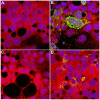Astrovirus infection in hospitalized infants with severe combined immunodeficiency after allogeneic hematopoietic stem cell transplantation
- PMID: 22096580
- PMCID: PMC3214048
- DOI: 10.1371/journal.pone.0027483
Astrovirus infection in hospitalized infants with severe combined immunodeficiency after allogeneic hematopoietic stem cell transplantation
Erratum in
- PLoS One. 2012;7(1). doi:10.1371/annotation/8371c305-a69c-4225-83ae-b0b414eca31a. Guengoer, Tayfun [corrected to Güngör, Tayfun]
Abstract
Infants with severe primary combined immunodeficiency (SCID) and children post-allogeneic hematopoietic stem cell transplantation (HSCT) are extremely susceptible to unusual infections. The lack of generic tools to detect disease-causing viruses among more than 200 potential human viral pathogens represents a major challenge to clinicians and virologists. We investigated retrospectively the causes of a fatal disseminated viral infection with meningoencephalitis in an infant with gamma C-SCID and of chronic gastroenteritis in 2 other infants admitted for HSCT during the same time period. Analysis was undertaken by combining cell culture, electron microscopy and sequence-independent single primer amplification (SISPA) techniques. Caco-2 cells inoculated with fecal samples developed a cytopathic effect and non-enveloped viral particles in infected cells were detected by electron microscopy. SISPA led to the identification of astrovirus as the pathogen. Both sequencing of the capsid gene and the pattern of infection suggested nosocomial transmission from a chronically excreting index case to 2 other patients leading to fatal infection in 1 and to transient disease in the others. Virus-specific, real-time reverse transcription polymerase chain reaction was then performed on different stored samples to assess the extent of infection. Infection was associated with viremia in 2 cases and contributed to death in 1. At autopsy, viral RNA was detected in the brain and different other organs, while immunochemistry confirmed infection of gastrointestinal tissues. This report illustrates the usefulness of the combined use of classical virology procedures and modern molecular tools for the diagnosis of unexpected infections. It illustrates that astrovirus has the potential to cause severe disseminated lethal infection in highly immunocompromised pediatric patients.
Conflict of interest statement
Figures





References
Publication types
MeSH terms
Substances
LinkOut - more resources
Full Text Sources
Medical

